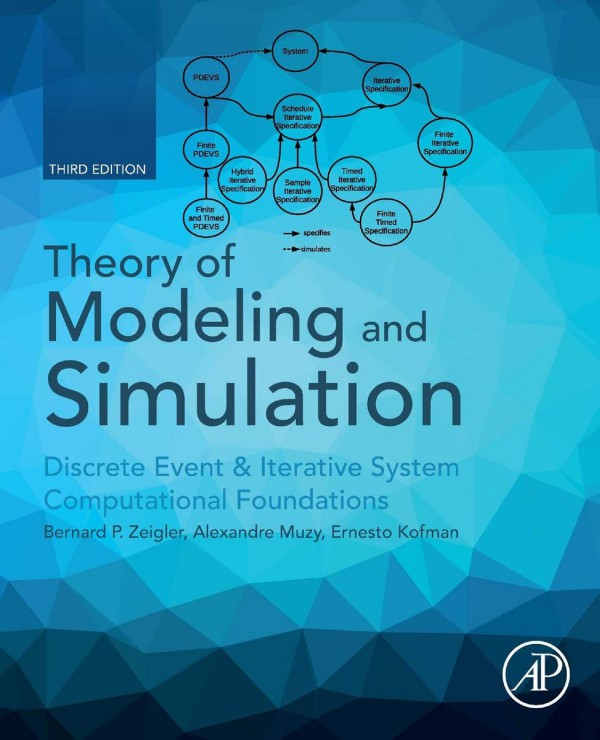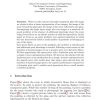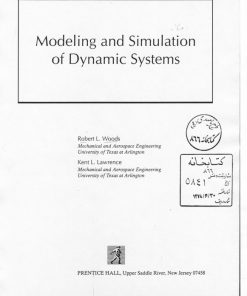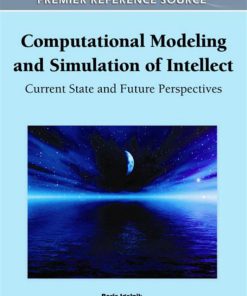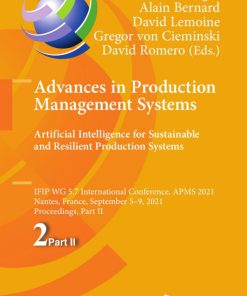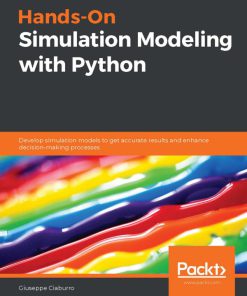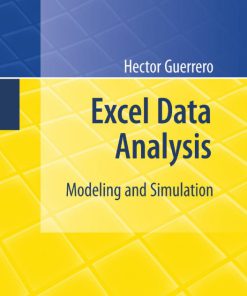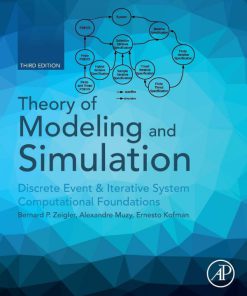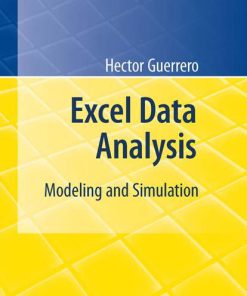Theory of Modeling and Simulation 3rd Edition by Bernard Zeigler, Alexandre Muzy, Ernesto Kofman 0128133708 9780128133705
$50.00 Original price was: $50.00.$25.00Current price is: $25.00.
Authors:Bernard P. Zeigler; Tag Gon Kim; Herbert Praehofer , Series:Computer Science [113] , Tags:Computers; Software Development & Engineering; General; Computer Engineering; Data Science; Data Modeling & Design; Hardware; Design; Graphics & Media; Graphics Tools; Technology & Engineering; Engineering (General); Industrial Design; Surveying , Author sort:Zeigler, Bernard P. & Kim, Tag Gon & Praehofer, Herbert , Ids:9780128133705 , Languages:Languages:eng , Published:Published:Jan 2019 , Publisher:Academic Press , Comments:Comments:The increased computational power and software tools available to engineers have increased the use and dependence on modeling and computer simulation throughout the design process. These tools have given engineers the capability of designing highly complex systems and computer architectures that were previously unthinkable. Every complex design project, from integrated circuits, to aerospace vehicles, to industrial manufacturing processes requires these new methods. This book fulfills the essential need of system and control engineers at all levels in understanding modeling and simulation. This book, written as a true text/reference has become a standard sr./graduate level course in all EE departments worldwide and all professionals in this area are required to update their skills.The book provides a rigorous mathematical foundation for modeling and computer simulation. It provides a comprehensive framework for modeling and simulation integrating the various simulation approaches. It covers model formulation, simulation model execution, and the model building process with its key activities model abstraction and model simplification, as well as the organization of model libraries. Emphasis of the book is in particular in integrating discrete event and continuous modeling approaches as well as a new approach for discrete event simulation of continuous processes. The book also discusses simulation execution on parallel and distributed machines and concepts for simulation model realization based on the High Level Architecture (HLA) standard of the Department of Defense. Presents a working foundation necessary for compliance with High Level Architecture (HLA) standards Provides a comprehensive framework for continuous and discrete event modeling and simulation Explores the mathematical foundation of simulation modeling Discusses system morphisms for model abstraction and simplification Presents a new approach to discrete event simulation of continuous processes Includes parallel and distributed simulation of discrete event models Presents a concept to achieve simulator interoperability in the form of the DEVS-Bus
Theory of Modeling and Simulation 3rd Edition by Bernard Zeigler, Alexandre Muzy, Ernesto Kofman – Ebook PDF Instant Download/Delivery. 0128133708, 9780128133705
Full download Theory of Modeling and Simulation 3rd Edition after payment
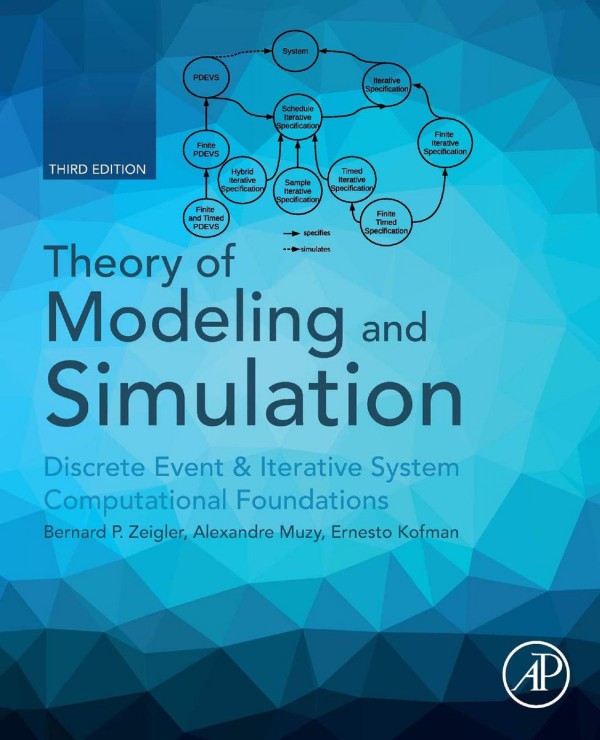
Product details:
ISBN 10: 0128133708
ISBN 13: 9780128133705
Author: Bernard Zeigler, Alexandre Muzy, Ernesto Kofman
Theory of Modeling and Simulation: Discrete Event & Iterative System Computational Foundations, Third Edition, continues the legacy of this authoritative and complete theoretical work. It is ideal for graduate and PhD students and working engineers interested in posing and solving problems using the tools of logico-mathematical modeling and computer simulation. Continuing its emphasis on the integration of discrete event and continuous modeling approaches, the work focuses light on DEVS and its potential to support the co-existence and interoperation of multiple formalisms in model components.
New sections in this updated edition include discussions on important new extensions to theory, including chapter-length coverage of iterative system specification and DEVS and their fundamental importance, closure under coupling for iteratively specified systems, existence, uniqueness, non-deterministic conditions, and temporal progressiveness (legitimacy).
- Presents a 40% revised and expanded new edition of this classic book with many important post-2000 extensions to core theory
- Provides a streamlined introduction to Discrete Event System Specification (DEVS) formalism for modeling and simulation
- Packages all the “need-to-know” information on DEVS formalism in one place
- Expanded to include an online ancillary package, including numerous examples of theory and implementation in DEVS-based software, student solutions and instructors manual
Theory of Modeling and Simulation 3rd Table of contents:
Part 1 Basics: Modeling Formalisms and Simulation Algorithms
1 Introduction to Systems Modeling Concepts
1.1 Systems Specification Formalisms
1.1.1 Relation to Object Orientation
1.1.2 Evolution of Systems Formalisms
1.1.3 Continuous and Discrete Formalisms
1.1.4 Quantized Systems
1.1.5 Extensions of DEVS
1.2 Levels of System Knowledge
1.3 Introduction to the Hierarchy of Systems Specifications
1.4 The Specification Levels Informally Presented
1.4.1 Observation Frame
1.4.2 I/O Behavior and I/O Function
1.4.3 State Transition System Specification
1.4.4 Coupled Component System Specification
1.5 System Specification Morphisms: Basic Concepts
1.6 Evolution of DEVS
1.7 Summary
1.8 Sources
Definitions, Acronyms, Abbreviations
References
2 Framework for Modeling and Simulation
2.1 The Entities of the Framework
2.1.1 Source System
2.1.2 Experimental Frame
Objectives and Experimental Frames
2.1.3 Model
2.1.4 Simulator
2.2 Primary Relations Among Entities
2.2.1 Modeling Relation: Validity
2.2.2 Simulation Relation: Simulator Correctness
2.3 Other Important Relationships
Modeling as Valid Simplification
Experimental Frame – Model Relationships
2.4 Time
2.5 Historical Trace of V&V Streams
2.5.1 Informal V&V Concepts and Processes
2.5.2 Theory-Based and Model-Driven Developments
2.5.3 Generic Methodology Processes and Best Practice Guides
2.6 Summary
2.7 Sources
References
3 Modeling Formalisms and Their Simulators
Introduction
3.1 Discrete Time Models and Their Simulators
3.1.1 Discrete Time Simulation
3.1.2 Cellular Automata
3.1.3 Cellular Automaton Simulation Algorithms
3.1.4 Discrete Event Approach to Cellular Automaton Simulation
3.1.5 Switching Automata/Sequential Machines
3.1.6 Linear Discrete Time Networks and Their State Behavior
3.2 Differential Equation Models and Their Simulators
3.2.1 Linear ODE Models
Non-Linear Models
3.2.2 Continuous System Simulation
3.2.3 Euler’s Methods
3.2.4 Accuracy of the Approximations
3.2.5 Convergence of the Numerical Scheme
3.2.6 Numerical Stability
3.2.7 One-Step Methods
Explicit Runge-Kutta Methods
Implicit One-Step Methods
3.2.8 Multi-Step Methods
Multi-Step Explicit Methods
Implicit Multi-Step Methods
3.2.9 Step Size Control
One-Step Methods
3.2.9.1 Multi-Step Methods
3.2.10 Stiff, Marginally Stable and Discontinuous Systems
Stiff Systems
Marginally Stable Systems
Discontinuous Systems
3.3 Discrete Event Models and Their Simulators
3.3.1 Introduction
3.3.2 Discrete Event Cellular Automata
3.3.3 Discrete Event World Views
Event Scheduling World View
3.4 Summary
3.5 Sources
References
4 Introduction to Discrete Event System Specification (DEVS)
4.1 Introduction
4.2 Classic DEVS System Specification
4.2.1 DEVS Examples
Passive
Storage
Generator
Binary Counter
Processor
Ramp
4.2.2 Classic DEVS With Ports
Switch
4.2.3 Classic DEVS Coupled Models
Simple Pipeline
Switch Network
4.3 Parallel DEVS System Specification
Processor With Buffer
4.3.1 Parallel DEVS Coupled Models
Simple Pipeline (Parallel DEVS)
4.4 Hierarchical Models
4.5 Object-Oriented Implementations of DEVS: an Introduction
4.5.1 Structural Inheritance
4.6 DEVS and Hierarchy of System Specifications: Turing Machine Example
4.6.1 Turing Machine as a Modular Composition
4.6.2 Tape System
4.6.3 TM Control
TM Example
4.6.4 Simulation of the TM Coupled Model
4.6.5 Example of Simulation Run
4.6.6 Turing Machine Example of Hierarchy of System Specifications
I/O Frame at Level 0
I/O Relation Observation at Level 1
I/O Function Observation at Level 2
DEVS I/O System Specification at Level 4
4.6.7 Empirical Investigation of Halting
4.7 Are DEVS State Sets Essentially Discrete?
4.8 Summary
4.9 Sources
References
5 Hierarchy of System Specifications
5.1 Time Base
5.2 Segments and Trajectories
5.2.1 Piecewise Continuous Segments
5.2.2 Piecewise Constant Segments
5.2.3 Event Segments
Correspondence Between Piecewise Constant and Event Segments
5.2.4 Sequences
5.3 I/O Observation Frame
5.4 I/O Relation Observation
5.5 I/O Function Observation
5.6 I/O System
5.6.1 Going From System Structure to Behavior
5.6.2 Time Invariant Systems
Example: Linear Systems
5.6.3 Special Cases: Input-Free and Memoryless Systems
Input-Free Systems
Memoryless Systems
5.7 Multi-Component System Specification
5.8 Network of System Specifications (Coupled Systems)
5.8.1 Coupled System Specification
5.8.2 Coupled System Specification at the Structured System Level
5.9 Summary
6 Basic Formalisms: DEVS, DESS, DTSS
6.1 Basic System Specification Formalisms
6.2 Discrete Event System Specification (DEVS)
6.2.1 Classic DEVS
6.2.2 Structure Specified by DEVS
6.2.3 Legitimacy: When is the Structure Specified by a DEVS Really a System?
6.3 Parallel DEVS
6.3.1 System Specified by Parallel DEVS
6.4 Discrete Time System Specification (DTSS)
6.5 Differential Equation System Specification (DESS)
6.6 Example of DESS
When is the System Specified by a DESS Well-Defined?
6.7 Summary
References
7 Basic Formalisms: Coupled Multi-Component Systems
7.1 Discrete Event Specified Network Formalism
7.1.1 Classic DEVS Coupled Models
Closure Under Coupling of Classic DEVS
7.1.2 Parallel DEVS Coupled Models
7.1.3 Closure Under Coupling of Parallel DEVS
Output Function
Internal Transition Function
External Transition Function
7.1.4 The Confluent Transition Function
7.2 Multi-Component Discrete Event System Formalism
7.2.1 Cellular Automata Multi-Component DEVS of GOL Event Model
Cellular Automata Multi-Component DEVS of GOL Event Model
7.2.2 Event Scheduling Models
Implementing Event Scheduling Simulation Systems in Imperative Programming Languages
7.2.3 Combined Event Scheduling, Activity Scanning Simulation Strategy
7.2.4 Process Interaction Models
7.2.5 Translating Non-Modular Multi-Component DEVS Models Into Modular Form
7.2.6 State Updating in Distributed Simulation
7.3 Discrete Time Specified Network Formalism
Delay-Free (Algebraic) Cycles
Definition of Discrete Time Coupled Models
Closure Under Coupling of DTSS
7.4 Multi-Component Discrete Time System Formalism
Spatial DTSS: Cellular Automata
7.5 Differential Equation Specified Network Formalism
Closure Under Coupling of DESS
7.6 Multi-Component Differential Equations Specified System Formalism
7.6.1 Spatial DESS: Partial Differential Equation Models
7.7 Multi-Component Parallel Discrete Event System Formalism
7.8 Summary
7.9 Sources
Appendix 7.A
References
8 Simulators for Basic Formalisms
8.1 Simulators for DEVS
8.1.1 Simulator for Basic DEVS
8.1.2 Simulators for Modular DEVS Networks
8.1.3 The Root-Coordinator
8.2 DEVS Bus
8.2.1 Simulator for Event Scheduling Multi-Component DEVS
8.2.2 Simulator for Activity Scanning and Process Interaction Multi-Component DEVS
8.3 Simulators for DTSS
8.3.1 Simulator for Atomic DTSS
8.3.2 Simulator for Instantaneous Functions
8.3.3 Simulator for Non-Modular Multi-Component DTSS
8.3.4 Simulators for Coupled DTSS
8.3.5 The Root-Coordinator
8.4 Simulators for DESS
8.4.1 Causal Simulator for DESS
8.4.2 Non-Causal Simulator for DESS
8.5 Summary
8.6 Sources
References
9 Multi-Formalism Modeling and Simulation
9.1 Brief Introduction to Specialized Formalisms
9.1.1 DESS Subformalisms: Systems Dynamics and Bond Graphs
9.1.2 DEVS Subformalisms: Petri Nets and Statecharts
9.2 Multi-Formalism Modeling
9.3 DEV&DESS: Combined Discrete Event and Differential Equation Specified Systems
9.3.1 A Simple Example: DEV&DESS Model of a Barrel Filler
9.3.2 System Specified by a DEV&DESS
9.4 Multi-Modeling With DEV&DESS
9.4.1 Example: Pot System With Command Inputs and Threshold Value Outputs
9.5 Coupled DEV&DESS: Network of Multi-Formalism Models
9.5.1 Basic Formalisms Are Subsumed by DEV&DESS
DESS Are Special DEV&DESS
DTSS Can Be Represented by Equivalent DEV&DESS
DEVS Can Be Represented by Equivalent DEV&DESS
9.5.2 Coupled DEV&DESS Formalism
9.6 Simulator for DEVS&DESS
9.6.1 The dev&dess-Simulator and -Coordinator
9.6.2 Integrating Different Modeling Formalisms
devs-Interface
dtss-Interface
dess-Interface
9.7 Update on DEV&DESS and Cyber-Physical Systems
9.8 Sources
Appendix 9.A The System Specified by a DEV&DESS
Appendix 9.B The System Specified by a Multi-Formalism System – Closure Under Coupling of Networks
References
Part 2 Iterative System Specification
10 Introduction to Iterative System Specification
10.1 Overview of Iterative System Specification
10.2 Abstraction, Formalization, and Implementation
10.3 Deriving Iterative System Specification
10.4 Input Generators
10.5 Progressivity and Well-Definition of Systems
10.6 Active/Passive Compositions
10.7 How Can Feedback Coupled Components Define a System?
10.8 Example: Emergence of Human Conversational Language Interaction
10.9 Simulation of Iterative System Specification by DEVS
10.10 Closure Under Coupling: Concept, Proofs, and Importance
10.10.1 Example: Multi-Level DEVS
10.10.2 Example: Routed DEVS
10.10.3 Example: Min-Max DEVS
10.11 Activity Formalization and Measurement
10.12 Summary
Appendix 10.A Activity Definitions
10.A.1 Activity of Continuous Segments
10.A.2 Event-Based Activity
Activity in a Discrete Event Set
Event-Based Activity in a Cartesian Space
10.A.3 Activity in Discrete Event System Specification (DEVS)
Model
Activity-Based Abstract Simulator
Abstract Simulator for Weighted Activity
References
11 Basic Iterative System Specification (IterSpec)
11.1 Basic Iterative System Specification: IterSpec Definition
11.2 Composition Process
11.3 Specific Maximal Length Segmentations
11.3.1 Definition of Specific Maximal Length Segmentations
11.3.2 Combination of Specific Maximal Length Segmentations
11.3.3 Iterative System Specification
11.4 Composition of Segments
11.5 Dilatable Generator Classes
11.6 Summary
Appendix 11.A
11.A.1 Generator Segments
References
12 Iterative Specification Subformalisms
12.1 Class Mapping of Iterative System Specifications
12.2 Basic Iterative Specification (IterSpec)
12.3 Scheduled Iterative System Specification
12.3.1 DEVS Is a Scheduled Iterative System Specification
12.4 Sample-Based Iterative System Specification
12.4.1 Formal Definition of Sample-Based Iterative System Specification
12.4.2 Preservation of Scheduled Time Under Update
12.4.3 Example of Sample-Based Iterative System Specification
12.4.4 System Specified by a Sample-Based Iterative Specification
12.5 Hybrid Iterative System Specification
12.5.1 Example of Hybrid Barrel Filling Iterative Specification
12.6 Coupled Iterative Specifications
12.7 Active-Passive Systems
12.8 DEVS Simulation of Iterative Specifications
12.9 Summary
Appendix 12.A Proof That DEVS Is a Scheduled Iterative System Specification
Appendix 12.B Coupled Iterative Specification at the I/O System Level
Appendix 12.C Composition Property for Sample-Based Systems
Appendix 12.D Closure Under Coupling of Sample-Based Iterative Specification
Appendix 12.E Abstract Simulator for Sample-Based Iterative Specification
Appendix 12.F Example of Closure Under Coupling: Memoryless Systems
Appendix 12.G Proof That a DEVS Atomic Model Can Simulate an Iterative Specification
References
13 Finite and Timed Iterative Specifications and Simulations
13.1 Time Management
13.2 Basic Finite Iterative Specification (FinIterSpec)
13.3 Finite PDEVS
13.4 Basic Timed Iterative Specification (TimedIterSpec)
13.5 Basic Finite Timed Iterative Specification (FiniTimedIterSpec)
13.6 Event Based Control and Finite Timed PDEVS
13.7 Summary
References
Part 3 System Morphisms: Abstraction, Representation, Approximation
14 Parallel and Distributed Discrete Event Simulation
James Nutaro Was the Primary Author of This Chapter
14.1 The Value of Information
14.2 The Value of Parallel Model Execution
14.3 Speedup, Scaling, and Parallel Execution
14.3.1 Parallel Experiments
14.3.2 Parallel Discrete Event Simulation
14.3.3 Understanding Speedup via State-Based Critical Path Analysis
14.4 Parallel DEVS Simulator
14.4.1 Critical Paths in PDEVS
14.5 Optimistic and Conservative Simulation
14.5.1 Conservative DEVS Simulator
14.5.2 Optimistic DEVS Simulator
14.5.3 Critical Paths in Optimistic and Conservative Simulators
14.5.4 Survey of Optimistic and Conservative Simulation Algorithms
14.5.5 A Statistical Approach to Speedup
14.6 Summary
References
15 Hierarchy of System Morphisms
15.1 The I/O Frame Morphism
15.2 The I/O Relation Observation Morphism
Example: Sampled Data Representation of Continuous I/O Signals
15.3 The I/O Function Morphism
Example: Scaling a System to Different Rates
15.3.1 IOFO System Morphism Implies IORO System Morphism
15.4 The I/O System Morphism
Example: Linear System Homomorphism
15.4.1 I/O System Morphism Implies IOFO and IORO Morphism
15.4.2 The Lattice of Partitions and the Reduced Version of a System
15.5 System Morphism for Iteratively Specified Systems
15.5.1 Iterative Specification Morphism Implies I/O System Morphism
15.5.2 Specialization of Morphisms for Iteratively Specified Systems
DTSS Specification Morphisms
Discrete Event Case
15.6 The Structured System Morphism
Example: Structure Morphism for Linear Systems
15.7 Multi-Component System Morphism
15.8 The Network of Systems Morphism
15.9 Homomorphism and Cascade Decompositions
15.10 Characterization of Realizable I/O Relations and Functions
15.10.1 Canonical Realization
15.11 Summary
15.12 Sources
References
16 Abstraction: Constructing Model Families
16.1 Scope/Resolution/Interaction Product
16.1.1 Complexity
16.1.2 Size/Resolution Trade-off: Simplification Methods
16.1.3 How Objectives and Experimental Frame Determine Abstraction Possibilities
16.2 Integrated Families of Models
16.2.1 Integrated Model Family Example: Space Travel
16.2.2 Space Travel Base Model
Why DEV&DESS?
Why Dynamic Structure?
Why Distributed Simulation?
16.3 Aggregation: Homogeneity/Coupling Indifference Principles
16.3.1 Coupling Conditions Imposed by Anonymity
16.3.2 Constructing Lumped Models Based on Identity-Erasing Aggregation
State Census Redistribution Under Equal Input
Output Census
Randomized Coupling
16.4 All-to-One Coupling
16.4.1 Example of Aggregation Model Construction: Space Travel
16.4.2 Constructing Lumped Models Based on Identity-Erasing Aggregation
State Census Mapping
Output Census
Input Census: All-to-All and Randomized Coupling
16.4.3 Example of Aggregation Model Construction: Space Travel
16.4.4 Constructing Aggregations Through State and Block Refinement
16.4.5 Universality/Applicability of Identity-Erasing Aggregations
16.5 Abstractions for Event-Based Control
16.5.1 Boundary-Based DEVS
16.5.2 DEVS Abstraction: Space Travel Example
16.6 Parameter Morphisms
16.6.1 Linear Systems Parameter Morphisms
16.6.2 Example Lumpable: Linear DTSS and Parameter Morphisms
16.6.3 Constraints on Parameter and State Spaces: Disaggregation
16.6.4 Using Parameter Morphisms in an Integrated Model Family
16.7 Summary
16.8 Sources
References
17 Verification, Validation, Approximate Morphisms: Living With Error
17.1 Verification
17.2 Validation at the Behavioral Level
17.2.1 Quantitative Comparison
17.2.2 Qualitative Comparison
17.3 Performance/Validity (e.g. Speed/Accuracy) Trade-off
Example of Speed/Accuracy Trade-off: Watershed Modeling
17.4 Approximate Morphisms and Error Behavior
17.4.1 Approximate Morphisms and the Specification Hierarchy
17.4.2 Approximate Homomorphisms and Error Propagation
Error Propagation and Accumulation: Bounded and Unbounded Growth
17.4.3 Example: Approximate Linear System Homomorphisms
17.5 Approximate Morphisms at the Coupled System Level
17.5.1 Error-Driven Aggregation Refinement
Identifying Critical Sources of Error
Effect of Error Accumulation
17.6 Validation at Structural Levels
17.6.1 Calibration, Parameter Identification, Sensitivity
17.6.2 Local/Global, Cross-Model Validation
17.7 Handling Time Granularity Together With Abstraction
17.8 Multi-Fidelity Modeling and Simulation Methodology
17.9 Summary
References
18 DEVS and DEVS-Like Systems: Universality and Uniqueness
Global vs. Local (Component-Wise) Representation
18.1 Relation Between Classical and Parallel DEVS: Are There One DEVS or Two?
18.2 Universality and Uniqueness of DEVS
18.2.1 Systems With DEVS Interfaces
18.2.2 Behavior of DEVS-Like Systems
18.2.3 Universality of DEVS
18.2.4 Example: DEVS Realization of DEVS-Like System
18.2.5 Uniqueness of DEVS
18.3 DEVS Representation of DTSS
18.3.1 Input-Free Moore
18.3.2 Multi-Ported FNSS
18.3.3 Moore DTSS With Input
18.3.4 Mealy DTSS
18.3.5 DEVS Strong Simulation of DTSS Coupled Models
Example: DEVS Strong Simulation of DTSS Network
18.4 Efficient DEVS Simulation of DTSS Networks
Summary
18.5 Sources
Appendix 18.A Isomorphically Representing DEVS-Like Systems by DEVS
References
19 Quantization-Based Simulation of Continuous Time Systems
19.1 Quantization Principles
19.1.1 A Motivating Example
19.1.2 Quantization and DEVS Representation
19.1.3 Generalization of Quantized Systems
19.2 Quantized State Systems
19.2.1 Hysteretic Quantization
19.2.2 First Order Quantized State Systems Method
19.2.3 DEVS Representation of QSS1
19.2.4 QSS1 Simulation Examples
19.2.5 QSS Legitimacy, Stability, Convergence, and Error Bounds
19.3 QSS Extensions
19.3.1 Higher Order QSS Methods
19.3.2 Linearly Implicit QSS
19.4 QSS Simulation of Hybrid Systems
19.5 Logarithmic Quantization
19.6 Software Implementations of QSS Methods
19.6.1 PowerDEVS
19.6.2 Stand Alone QSS Solver
19.7 Applications of QSS Methods
19.7.1 A DC-DC Buck Converter Circuit
19.7.2 A Population of Air Conditioners
19.7.3 Advection-Diffusion-Reaction Equation
19.8 Comparison of QSS With Discrete Time Methods: Activity-Based Approach
Sources and Further Reading
Exercise for Future Research
References
20 DEVS Representation of Iteratively Specified Systems
20.1 DEVS Bus Revisited
20.1.1 Approaches to DEVS Representation of Continuous Systems
20.2 DEVS Simulation of DESS With Arbitrarily Small Error
20.2.1 Discretized Simulation of a DESS With Arbitrarily Small Error
20.2.2 Discretized Simulation of Coupled DESSs With Arbitrarily Small Error
20.2.3 Simulation of a DESS by QSS With Arbitrarily Small Error
20.2.4 QSS Simulation of Coupled DESS With Arbitrarily Small Error
20.2.5 Convergence of Coupling of QSS and DTSS
20.3 DEVS Component-Wise Simulation of Iteratively Specified Coupled Systems
20.4 Simulation Study of Message Reduction Under Quantization
20.4.1 Some Indicative Simulation Results
20.4.2 Comparing Quantized DEVS With DTSS in Distributed Simulation of DESS
20.4.3 Insight From 2nd Order Linear Oscillator
20.4.4 Conjectures for Further Research
Caveat: Effect of Integration Method
20.5 Summary
20.6 Sources
References
Part 4 Enhanced DEVS Formalisms
21 DEVS Markov Modeling and Simulation
21.1 Markov Modeling
21.2 Background
21.3 Mapping DEVS Markov Models
21.3.1 General Framework for Stochastic DEVS
21.3.2 Stochastic DEVS With Finite Sets
21.3.3 SES for DEVS Markov Models
21.3.4 Uncoupling Decision Probabilities from Transition Times
21.3.4.1 DEVS Markov Model Classes
21.4 Hidden Markov Models
21.5 Preview: Closure Under Coupling of DEVS Markov Models
21.5.1 System Specification Hierarchy for Hidden Markov Models
21.6 Formalization of DEVS Markov Models
21.6.1 Probability Core DEVS
21.6.2 Markov Chain
21.6.2.1 Example of DEVS Markov Core
21.6.3 Transient Behavior
21.6.4 Extension With Input/Output Sets and Functions
21.6.5 Input/Output Behavior of DEVS Markov Models
21.6.6 Coupled Models – DEVS Networks of Markov Components
21.6.7 Proof of DEVS Markov Class Closure Under Coupling
21.7 Continuous and Discrete Time Subclasses of Markov Models
21.8 Relations Between DEVS CTM and DTM
21.8.1 Example: DEVS Markov Coupled Model
Mobile Worker
21.8.2 DEVS Hidden Markov Models
21.8.3 Example: Dynamic Structure via Variable Transition Probability
Appendix 21.A Exponential Distribution and Markov Model Basics
21.A.1 Exponential Distribution Properties
21.A.2 Zero-Memory Property
21.A.3 Poisson Process
21.A.4 Markov Modeling
Appendix 21.B Traditional Approach to CTM Implementation
References
22 DEVS Markov Model Lumping
22.1 Overall Approach
22.2 Homomorphism of Timed Non-Deterministic Models
22.3 Homomorphism of DEVS Markov Models
22.3.1 Random Phase Regime for Coupled DEVS Markov Models
22.4 Example: Combat Attrition Modeling
22.4.1 Base Model Component: Realizing a Poisson Process With DEVS Markov Model
22.4.2 Base Coupled Model
Lumped Model Component
22.4.3 Lumped Coupled Model
22.4.4 Homomorphism From Base to Lumped Models
22.5 Approximate Morphisms
22.5.1 Introducing Non-Uniformity Into the Base Model
22.5.2 Lumpability Zone Evaluation for Departure in Uniformity of Structure
Lumpability Dependence on Force Ratio
Lumpability Dependence on Force Sizes
Departure From Uniformity in Coupling
Lumpability Dependence on Distribution of Fire
22.6 Application to General Markov Matrix Lumpability
22.7 Lumping of DEVS Markov Models to Study Speedup in Multiprocessor Computation
22.7.1 Base Model of Multiprocessor
22.7.2 Relation Between Speedup and Probability of Active State
22.7.3 Lumped Model of Multiprocessor
22.7.4 Taking Component Identity Into Account
22.8 Summary
Appendix 22.A Prioritized Communication in Multiprocessor Clusters
References
23 Spiking Neuron Modeling – Iterative Specification
23.1 A Biological Neuron as a Dynamic System
23.2 Discrete Event Modeling of a Leaky Integrate and Fire Neuron
23.3 Multi-Level Iterative Specification
23.4 Iterative Specification Modeling of Spiky Neurons
23.5 Summary
Appendix 23.A Iterative System Specification of a Spiking Neuron
Appendix 23.B Iterative Specification Modeling of Bursty Neurons
References
24 Open Research Problems: Systems Dynamics, Complex Systems
Rodrigo Castro Was the Primary Author of This Chapter
24.1 Systems Dynamics, DEVS, and Challenges for M&S of Complex Systems
24.1.1 Introduction
24.2 System Dynamics
SD Basics
24.2.1 SD Strengths and Limitations
24.3 Mapping SD Into DEVS
24.3.1 XMILE
24.3.2 DEVSML
24.3.3 Core Mapping Idea
24.3.4 Example: Prey-Predator Model
24.3.5 Experimental Results
24.4 Challenges for Sound Interdisciplinary M&S of Large Complex Systems: the Case of Socio-Ecologic
24.4.1 Brief History of Global Modeling
24.4.2 Current M&S Challenges in Global Models
24.5 Theory-Based Research Needed
People also search for Theory of Modeling and Simulation 3rd:
theory of modeling and simulation
simulation theory pdf
simulation modeling and analysis 5th edition
4 types of mathematical models

